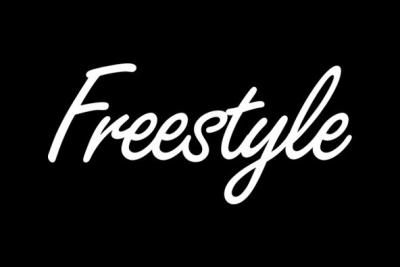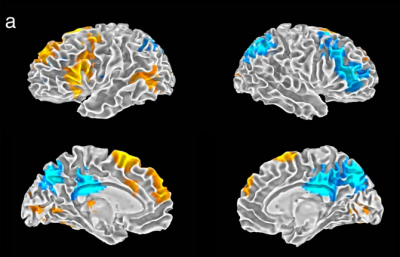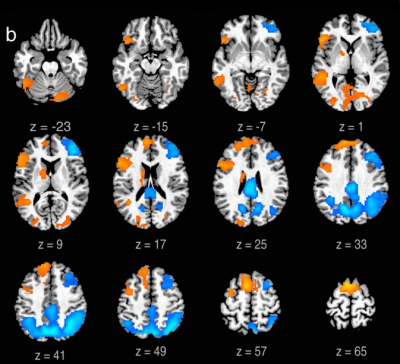
FREESTYLE ♫ multidimensional form of Creativity! Scientifically explaining this phenomenon, it is said that, during a flow state there is significant changes or an increased activity in the prefrontal cortex, the brain region associated with language and decision-making. During freestyle session for instance, the words improvisation increases activity in the area responsible for thoughts and actions, the prefrontal cortex, but at the same time those part of the brain that are responsible for self-monitoring and editing ‘shuts down’
The Neuroanatomy of Freestyle Rap ♫ Hallmark of Creativity
The neural correlates of creativity are poorly understood. Freestyle rap provides a unique opportunity to study spontaneous lyrical improvisation, a multidimensional form of creativity at the interface of music and language. Here we use functional magnetic resonance imaging to characterize this process. Task contrast analyses indicate that improvised performance is characterized by dissociated activity in medial and dorsolateral prefrontal cortices, providing a context in which stimulus-independent behaviors may unfold in the absence of conscious monitoring and volitional control. Connectivity analyses reveal widespread improvisation-related correlations between medial prefrontal, cingulate motor, perisylvian cortices and amygdala, suggesting the emergence of a network linking motivation, language, affect and movement. Lyrical improvisation appears to be characterized by altered relationships between regions coupling intention and action, in which conventional executive control may be bypassed and motor control directed by cingulate motor mechanisms. These functional reorganizations may facilitate the initial improvisatory phase of creative behavior.
Hip-Hop music, in particular rap, has had a huge cultural impact in western society, especially among the young, since its appearance four decades ago. Freestyle rap, a popular form, requires an artist to freely improvise rhyming lyrics and novel rhythmic patterns, guided by the instrumental beat – a particularly challenging form of spontaneous artistic creativity.
It has been proposed that artistic creativity is itself a twofold process, in which an initial improvisatory phase, characterized by spontaneous generation of novel material, is followed by a period of focused re-evaluation and revision. The neural correlates of the improvisatory phase are poorly understood Freestyle rap thus provides a unique opportunity to study this initial, improvisatory phase at the interface of music and language.
In an attempt to identify the neural correlates of spontaneous lyrical improvisation in this context we compared freestyle (improvised) to conventional (rehearsed) performance, using functional magnetic resonance imaging (fMRI). Utilizing spatial independent component analysis (sICA) methods recently developed in this laboratory to effectively remove imaging artifacts associated with connected speech or song, has made it possible to study this unique genre using fMRI for the first time. Importantly, in order to study spontaneous lyrical improvisation in its most natural form, our design evaluated the natural and ecologically valid process: freestyle artists producing freestyle rap, unencumbered by unrelated cognitive demands.
Spontaneous improvisation is a complex cognitive process that shares features with what has been characterized as a ‘flow’ state. It has been suggested that the frontal lobe, may play a central role in the improvisatory process, although the nature of its contributions is unclear. On this basis, in addition to its other characteristics, we expected the neural correlates of lyrical improvisation to include changes in prefrontal activity that might enable spontaneous creative activity through effects on systems that regulate attention, affect, language and motor control.
Our results support these predictions and provide a novel model for improvisation characterized by functional changes within a large-scale network that is anchored in the frontal lobe. This pattern – activation of medial and deactivation of dorsolateral cortices – may provide a context in which self-generated action is freed from the conventional constraints of supervisory attention and executive control, facilitating the generation of novel ideas. Importantly, altered relationships within the prefrontal cortex appear to have widespread functional consequences, affecting motivation, emotion, language as well as motor control and may generalize to other forms of spontaneous creative behavior.
Scientific Reports volume 2, Article number: 834 (2012) BY: Siyuan Liu, Ho Ming Chow, Yisheng Xu, Michael G. Erkkinen, Katherine E. Swett, Michael W. Eagle, Daniel A. Rizik-Baer & Allen R. Braun
WEBSITE: https://www.theatlantic.com/health/archive/2012/11...

This is your Brain on Freestyle Rap ♫ DCD study reveals characteristic brain patterns of Lyrical Improvisation
Researchers in the voice, speech, and language branch of the National Institute on Deafness and Other Communication Disorders (NIDCD) at the National Institutes of Health have used functional magnetic resonance imaging to study the brain activity of rappers when they are “freestyling” – spontaneously improvising lyrics in real time. The findings, published online in the Nov. 15 issue of the journal Scientific Reports, reveal that this form of vocal improvisation is associated with a unique functional reallocation of brain activity in the prefrontal cortex and proposes a novel neural network that appears to be intimately involved in improvisatory and creative endeavors.
The researchers, led by Siyuan Liu, Ph.D., scanned the brains of 12 freestyle rap artists (who had at least 5 years of rapping experience) while they performed two tasks using an identical 8-bar musical track. For the first task, they improvised rhyming lyrics and rhythmic patterns guided only by the beat. In the second task, they performed a well-rehearsed set of lyrics.
During freestyle rapping, the researchers observed increases in brain activity in the medial prefrontal cortex, a brain region responsible for motivation of thought and action, but decreased activity in dorsolateral prefrontal regions that normally play a supervisory or monitoring role. Like an experienced parent who knows when to lay down the law and when to look the other way, these shifts in brain function may facilitate the free expression of thoughts and words without the usual neural constraints.
Freestyling also increased brain activity in the perisylvian system (involved in language production), the amygdala (an area of the brain linked to emotion), and cingulate motor areas, suggesting that improvisation engages a brain network that links motivation, language, mood, and action. Further studies of this network in other art forms that involve the innovative use of language, such as poetry and storytelling, could offer more insights into the initial, improvisatory phase of the creative process.
WEBSITE: https://www.nih.gov/news-events/news-releases/your...

Neural Correlates of Lyrical Improvisation ♫ An fMRI Study of Freestyle Rap
Mapping the fugue state that allows rappers to freestyle, jazz musicians to improvise, and artists turn off their self-edit
"Flow": What academics define as "a subject's complete immersion in creative activity, typified by focused self-motivation, positive emotional valence, and loss of self-consciousness," or, per the inimitable Urban Dictionary, "a rapper's ability to rhyme to phat beats in a skillful manner."
Accepting that second definition as an accurate example of the first, neuroscientists at the National Institute on Deafness and Other Communication Disorders took 12 professional rappers and ran them through an fMRI machine. While their brains were being scanned, the artists listened to an 8-bar instrumental track and were asked to rap -- first memorized lyrics and then their own, unrehearsed rhymes. That is, what academics call "spontaneous lyrical improvisation" and the rest of us know as freestyle. Flat on their backs, with their heads restrained from nodding, the artists were nonetheless able to enter the flow; and the researchers were able to identify huge differences in their brain activity:
Basically, what they noticed was that during freestyle, there were significant changes in the prefrontal cortex (credit where credit is due: Jonah Lehrer was spot on about this part of the brain being integral to the creative process). The areas implicated in processes like organization and drive were marked by an increase in activity, while those parts responsible for close self-monitoring and editing were deactivated. In this context, the authors explain, "self-generated action is freed from the conventional constraints of supervisory attention and executive control," allowing sudden insights, seemingly unbidden, to emerge.
In other words, in order to turn on their creative flow, the rappers had to switch off their inner critic. And in fact, the researchers believe that when they're freestyling, the artists are actually occupying an altered state of mind. A closer look at their brain activity reveals that an entire, unique network emerges during the process, one in which motivation, language, emotion, motor function, sensory processing and the representation of the artists' subject experience all interact in unusual ways to create the flow state.
And it's not just rappers: The authors believe that their findings can be extrapolated to explain creativity itself. Specifically, they point to the first phase of any artist's process, in which unrestrained bursts of inspiration and ideas are brought forth. In other forms of art, like writing, those ideas are later edited and revised.
The idea of studying creativity's roots in freestyle is actually a takeoff from a similar study done with improvisational jazz, in which six musicians played a specially designed keyboard from within the bowels of an fMRI machine. For these artists, playing a one octave C-major scale in quarter notes was also associated markedly different brain activity than when they were allowed to start improvising within those parameters.
Here, the researchers called special attention to increased activity that was observed in the part of the brain associated with the inner self, the subjective perspective unmediated by outside stimuli. That improvisation is the expression of an artist's musical voice, they argue, further strengthens these associations. It raises the question: Could this mean that we're most genuine during the first stage of the creative process, later to be mediated during the revision stage by outside constraints?
In the absence of self-editing, the researchers further noted of the freestyle experience, "ongoing actions, moment to moment decisions and adjustments in performance may be experienced as having occurred outside of conscious awareness." This, they suggest, could explain why artists sometimes claim the guiding influence of some outside agency on their creative process. But, as they insist they've demonstrated with the jazz musicians, "the process is neither mysterious nor obscure, but is instead predicated on novel combinations of ordinary mental processes."
Which is not, they might do well to add, to diminish the wonder we experience during a burst of creative expression, or our appreciation of seeing (or, more accurately, hearing) it occur in others. That changes in brain activity are so clear, and so obviously powerful, only confirms the extraordinary nature of the creative mind.
WEBSITE: https://www.nature.com/articles/srep00834?fbclid=I...





